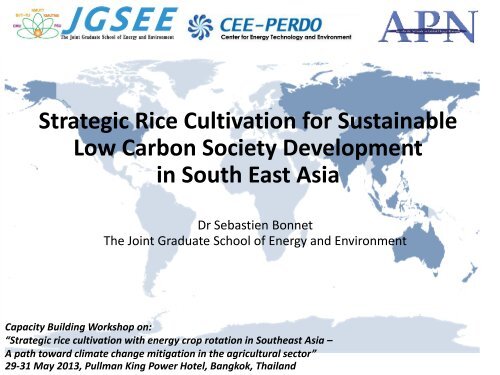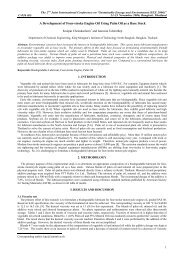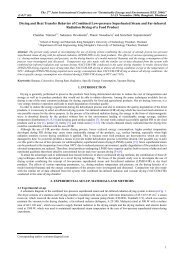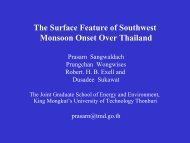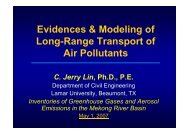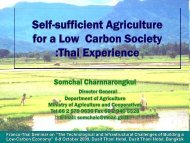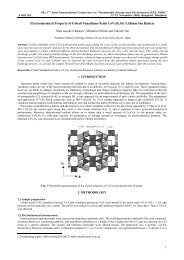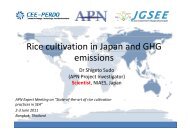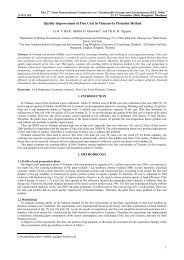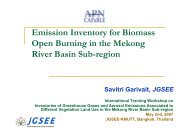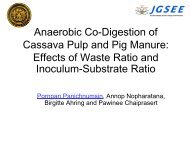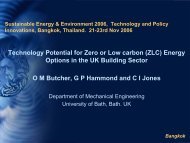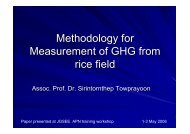Strategic rice cultivation with energy crop rotation in Southeast Asia
Strategic rice cultivation with energy crop rotation in Southeast Asia
Strategic rice cultivation with energy crop rotation in Southeast Asia
You also want an ePaper? Increase the reach of your titles
YUMPU automatically turns print PDFs into web optimized ePapers that Google loves.
<strong>Strategic</strong> Rice Cultivation for Susta<strong>in</strong>able<br />
Low Carbon Society Development<br />
<strong>in</strong> South East <strong>Asia</strong><br />
Dr Sebastien Bonnet<br />
The Jo<strong>in</strong>t Graduate School of Energy and Environment<br />
Capacity Build<strong>in</strong>g Workshop on:<br />
“<strong>Strategic</strong> <strong>rice</strong> <strong>cultivation</strong> <strong>with</strong> <strong>energy</strong> <strong>crop</strong> <strong>rotation</strong> <strong>in</strong> <strong>Southeast</strong> <strong>Asia</strong> –<br />
A path toward climate change mitigation <strong>in</strong> the agricultural sector”<br />
29-31 May 2013, Pullman K<strong>in</strong>g Power Hotel, Bangkok, Thailand
The <strong>Asia</strong>-Pacific Network for Global Change Research - APN<br />
• APN: The <strong>Asia</strong>-Pacific Network for Global Change Research<br />
• APN is a network of 22 member countries promot<strong>in</strong>g global change research<br />
<strong>in</strong> the region and strengthen<strong>in</strong>g <strong>in</strong>teractions between scientists and policymakers<br />
• The APN funds its research programmes based on an annual open call for<br />
proposals under its regional research and capacity development<br />
programmes (ARCP and CAPaBLE).<br />
• ARCP: <strong>Asia</strong> Pacific Network - Annual Regional Call for Research Proposals<br />
• ARCP is one of the scientific pillars of the APN to encourage and promote<br />
global change research <strong>in</strong> the <strong>Asia</strong>-Pacific region, establish<strong>in</strong>g a sound<br />
scientific basis for policy-mak<strong>in</strong>g.
APN-ARCP project led by JGSEE<br />
• Project title: <strong>Strategic</strong> Rice Cultivation for Susta<strong>in</strong>able Low Carbon Society<br />
Development <strong>in</strong> South East <strong>Asia</strong><br />
• Project duration: 2 years<br />
• Budget: 40,000 USD per year<br />
• Organizations <strong>in</strong>volved:<br />
– The Jo<strong>in</strong>t Graduate School of Energy and Environment (JGSEE), Thailand<br />
Lead organization (Assoc. Prof. Dr. Sir<strong>in</strong>tornthep Towprayoon)<br />
– The National Institute for Agro-Environmental Sciences (NIAES), Japan<br />
– Bogor Agricultural University, Indonesia
Project objectives<br />
• The overall goal of the project is to identify strategic <strong>rice</strong> <strong>cultivation</strong> practices<br />
enabl<strong>in</strong>g SEA to develop towards a susta<strong>in</strong>able low carbon society while<br />
enhanc<strong>in</strong>g the adaptive capacity <strong>in</strong> the agriculture sector<br />
• The specific objectives are:<br />
– To develop long-term field studies to measure, monitor and evaluate<br />
the impacts of various <strong>cultivation</strong> practices on climate change and<br />
identify potential adaptive measures and mitigation options<br />
– To identify strategic <strong>rice</strong> <strong>cultivation</strong> practices, <strong>in</strong> <strong>rotation</strong> <strong>with</strong> selected<br />
<strong>energy</strong> <strong>crop</strong>s, enabl<strong>in</strong>g to fully utilize the <strong>rice</strong> plantation fallow period<br />
and therefore to optimize <strong>rice</strong> and <strong>energy</strong> feedstock production<br />
– To enhance regional capacity of scientists and policy makers <strong>in</strong> SEA for<br />
susta<strong>in</strong>able low carbon development of their society
Activity I: Review of <strong>rice</strong><br />
<strong>cultivation</strong> practices and use of<br />
<strong>energy</strong> <strong>crop</strong>s for <strong>rotation</strong> <strong>in</strong> SEA<br />
Activity II: Long-term monitor<strong>in</strong>g<br />
of GHG emissions and soil carbon<br />
dynamics from <strong>rice</strong> <strong>cultivation</strong><br />
and utilization <strong>energy</strong> <strong>crop</strong>s for<br />
<strong>rotation</strong><br />
Activity V: Knowledge<br />
dissem<strong>in</strong>ation to scientists and<br />
policy-makers <strong>in</strong> SEA<br />
Project<br />
activities<br />
Activity III: Capacity assessment of<br />
GHG emissions and carbon stock<br />
from susta<strong>in</strong>able <strong>cultivation</strong><br />
practices <strong>in</strong> SEA<br />
Activity IV: Long-term soil carbon<br />
dynamics assessment of<br />
susta<strong>in</strong>able low carbon <strong>cultivation</strong><br />
us<strong>in</strong>g process model
Activity I: Review of <strong>rice</strong> <strong>cultivation</strong> practices and use of <strong>energy</strong><br />
<strong>crop</strong>s for <strong>rotation</strong> <strong>in</strong> SEA<br />
Description of Tasks<br />
– Review of <strong>in</strong>formation on<br />
current <strong>rice</strong> <strong>cultivation</strong><br />
practices <strong>in</strong> SEA and state-ofthe-art<br />
of regional traditional<br />
practices as well as potential<br />
for <strong>in</strong>troduc<strong>in</strong>g selected<br />
<strong>energy</strong> <strong>crop</strong>s to be cultivated<br />
<strong>in</strong> <strong>rotation</strong> <strong>with</strong> <strong>rice</strong>.<br />
– Involvement of SEA experts <strong>in</strong><br />
the agricultural sector to<br />
contribute <strong>in</strong>formation to the<br />
review study as part of an<br />
expert meet<strong>in</strong>g organised <strong>in</strong><br />
Thailand by JGSEE<br />
Deliverables<br />
— Report on the state-of-the-art<br />
of <strong>rice</strong> <strong>cultivation</strong> practices and<br />
use of <strong>energy</strong> <strong>crop</strong>s as the<br />
potential <strong>rotation</strong> <strong>crop</strong>s for SEA<br />
countries.<br />
— Database of <strong>rice</strong> <strong>cultivation</strong><br />
practices <strong>in</strong> SEA<br />
— Identification of country<br />
specific <strong>rice</strong> <strong>cultivation</strong><br />
practices and potentials for<br />
<strong>energy</strong> <strong>crop</strong> <strong>cultivation</strong> <strong>in</strong> SEA<br />
countries<br />
— Background data for<br />
preparation of Activity II and III
Activity I: Review of <strong>rice</strong> <strong>cultivation</strong> practices and use of <strong>energy</strong><br />
<strong>crop</strong>s for <strong>rotation</strong> <strong>in</strong> SEA<br />
• Literature survey to assess current practices of <strong>rice</strong> <strong>cultivation</strong> <strong>in</strong> SEA <strong>in</strong>clud<strong>in</strong>g<br />
land management.<br />
• Review supported <strong>with</strong> a questionnaire survey (<strong>in</strong> Thailand and Indonesia) to<br />
collect <strong>in</strong>formation from farmers regard<strong>in</strong>g their agricultural practices and<br />
assess<strong>in</strong>g potentials for <strong>rotation</strong> <strong>with</strong> selected <strong>energy</strong> <strong>crop</strong>s, i.e. maize and<br />
sorghum.<br />
• Expert meet<strong>in</strong>g organized by JGSEE <strong>in</strong> June 2011 gather<strong>in</strong>g selected experts from<br />
SEA countries <strong>in</strong>clud<strong>in</strong>g: Indonesia, Japan, Cambodia, Lao PDR, Myanmar, Vietnam<br />
and Thailand to help evaluat<strong>in</strong>g and confirm<strong>in</strong>g the results from the literature<br />
review.<br />
• Production of a Report on: “State-of-the-art of <strong>rice</strong> <strong>cultivation</strong> practices <strong>in</strong> SEA and<br />
<strong>rotation</strong> <strong>with</strong> <strong>energy</strong> <strong>crop</strong>s”.<br />
• Presentation on “Rice Cultivation and Potential Areas for Rotation <strong>with</strong> Energy<br />
Crops <strong>in</strong> South-east <strong>Asia</strong>” at the 17 th Inter-Governmental Meet<strong>in</strong>g (IGM) and<br />
Scientific Plann<strong>in</strong>g Group (SPG) Meet<strong>in</strong>g <strong>in</strong> Jakarta (Indonesia), on 14 March 2012.
Expert Meet<strong>in</strong>g on<br />
“State-of-the-Art of Rice Cultivation Practices <strong>in</strong> South-East <strong>Asia</strong>”<br />
2-3 June 2011<br />
JGSEE, Bangkok, Thailand<br />
Under APN-ARCP Funded Project on:<br />
Rice Cultivation for Susta<strong>in</strong>able Low Carbon Society Development <strong>in</strong> South-East <strong>Asia</strong><br />
Organized by<br />
The Jo<strong>in</strong>t Graduate School of Energy and Environment (JGSEE)<br />
Participants<br />
Thailand<br />
Card technique<br />
Japan<br />
Cambodia<br />
Indonesia<br />
Myanmar
Activity I: Report on “State-of-the-art of <strong>rice</strong> <strong>cultivation</strong> practices<br />
for selected countries <strong>in</strong> SEA and <strong>rotation</strong> <strong>with</strong> <strong>energy</strong> <strong>crop</strong>s”<br />
• The report provides background <strong>in</strong>formation on statistics of <strong>rice</strong> <strong>cultivation</strong> <strong>in</strong><br />
selected SEA countries <strong>in</strong>clud<strong>in</strong>g harvested area, production, yield, trade as<br />
well as <strong>rice</strong> varieties and ecosystems<br />
• The report also provides country specific <strong>in</strong>formation for : Cambodia,<br />
Indonesia, Lao PDR, Myanmar, Thailand and Vietnam<br />
• The <strong>in</strong>formation reviewed and reported <strong>in</strong>cludes:<br />
– Rice variety<br />
– Agro-cosystem<br />
– Land preparation<br />
– Rice plantation and <strong>cultivation</strong> practices (water, fertiliser, pesticide, etc.)<br />
– Harvest<strong>in</strong>g method<br />
– Management of <strong>rice</strong> residues<br />
– Rotation <strong>crop</strong>s<br />
– Soil organic carbon<br />
– Socio-economic status of farmers
Activity I: Overview on <strong>rice</strong> production<br />
• Rice is grown <strong>in</strong> more than 100 countries<br />
• Global <strong>rice</strong> plantation cover<strong>in</strong>g 12.5% of total <strong>crop</strong> plantation area<br />
• The global <strong>rice</strong> area harvested at present represents more than 150 Mha,<br />
but the amount of land used for <strong>rice</strong> is less, <strong>in</strong> the order of about 125 million<br />
hectares, because <strong>in</strong> some fields farmers plant two, or even three, <strong>rice</strong> <strong>crop</strong>s<br />
each year,<br />
• Annual production is near<strong>in</strong>g 630 Mt of rough (unmilled) <strong>rice</strong> 95 kg for<br />
each person on Earth
Activity I: Overview on <strong>rice</strong> production<br />
• Rice is most closely associated <strong>with</strong> South, <strong>Southeast</strong>, and East <strong>Asia</strong>,<br />
where 90% of the world's <strong>rice</strong> is produced.<br />
• Almost half of the global <strong>rice</strong> area is <strong>in</strong> India and Ch<strong>in</strong>a, the 2 largest world<br />
producer of <strong>rice</strong><br />
• The eight countries <strong>with</strong> the largest area of <strong>rice</strong> are all <strong>in</strong> South and<br />
<strong>Southeast</strong> <strong>Asia</strong> (80%), <strong>in</strong>clud<strong>in</strong>g:<br />
• India,<br />
• Ch<strong>in</strong>a,<br />
• Indonesia,<br />
• Bangladesh,<br />
• Thailand,<br />
• Vietnam,<br />
• Myanmar, and<br />
• the Philipp<strong>in</strong>es<br />
30 % of the global <strong>rice</strong> area is found <strong>in</strong> SEA
Overview harvested area of <strong>rice</strong> <strong>in</strong> SEA
Activity I: Rice agro-ecosystems<br />
There are primarily four agro-ecosystems where <strong>rice</strong> is grown:<br />
• Irrigated <strong>rice</strong> (80 Mha, 75% global <strong>rice</strong> production, typically found <strong>in</strong><br />
Ch<strong>in</strong>a, Japan, Indonesia, Vietnam and Korea)<br />
• Ra<strong>in</strong>fed lowlands (60 Mha (46Mha <strong>in</strong> <strong>Asia</strong>), 20% global <strong>rice</strong> production,<br />
typically found <strong>in</strong> eastern India and SEA)<br />
• Upland <strong>rice</strong> (14Mha, 4% global <strong>rice</strong> production, typically found <strong>in</strong><br />
Indonesia, the Philipp<strong>in</strong>es and Southwest Ch<strong>in</strong>a)<br />
• Flood‐prone ecosystem (11Mha, 1% global <strong>rice</strong> production, typically<br />
found <strong>in</strong> Bangladesh, the Irrawaddy of Myanmar, the Mekong region of<br />
Vietnam and Cambodia, and the Chao Phraya bas<strong>in</strong> of Thailand)
Activity I: Ma<strong>in</strong> features of <strong>rice</strong> production <strong>in</strong> SEA<br />
• Cultivation practices of <strong>rice</strong> <strong>in</strong> SEA do not differ much.<br />
• Climate is a factor that classifies <strong>rice</strong> <strong>cultivation</strong> <strong>in</strong>to wet and dry season, and<br />
each country <strong>in</strong> SEA refers to wet and dry season <strong>in</strong> a different way, e.g.<br />
• Wet season of <strong>rice</strong> (WS) and dry season of <strong>rice</strong> (DS) <strong>in</strong> Cambodia;<br />
• Monsoon <strong>rice</strong> and summer <strong>rice</strong> <strong>in</strong> Myanmar; and<br />
• Major <strong>rice</strong> and second <strong>rice</strong> <strong>in</strong> Thailand.<br />
• There are 2 ma<strong>in</strong> plant<strong>in</strong>g methods used for <strong>rice</strong>,<br />
• Broadcast<strong>in</strong>g - large scale production, not labor <strong>in</strong>tensive<br />
• Transplant<strong>in</strong>g - traditional method, labour <strong>in</strong>tensive, found ma<strong>in</strong>ly <strong>in</strong> NE<br />
of Thailand, small farms <strong>in</strong> Cambodia, most areas <strong>in</strong> Lao PDR, 80% of <strong>rice</strong><br />
farms <strong>in</strong> Myanmar, and traditional farms <strong>in</strong> Vietnam).
Activity I: Ma<strong>in</strong> features of <strong>rice</strong> production <strong>in</strong> SEA<br />
• Chemical fertilizers are applied <strong>in</strong> paddy fields <strong>in</strong> most SEA countries,<br />
especially for <strong>rice</strong> cultivated via modern methods. For traditional farm<strong>in</strong>g <strong>in</strong><br />
mounta<strong>in</strong>ous areas, organic fertilizers are still ma<strong>in</strong>ly applied.<br />
• The harvest<strong>in</strong>g of <strong>rice</strong> can be performed either manually (us<strong>in</strong>g sickles) or by<br />
mach<strong>in</strong>e. In SEA, harvest<strong>in</strong>g mach<strong>in</strong>es are ma<strong>in</strong>ly used <strong>in</strong> lowland areas<br />
(dom<strong>in</strong>ant <strong>in</strong> ASEAN) easy of access.<br />
• Rotation <strong>crop</strong>s are planted mostly <strong>in</strong> non-irrigated paddy fields dur<strong>in</strong>g the<br />
fallow period and <strong>with</strong> enough water for <strong>cultivation</strong>. The <strong>rotation</strong> <strong>crop</strong>s are<br />
legumes, fruits, and vegetable.
Activity II: Long-term monitor<strong>in</strong>g of GHG emissions and soil carbon<br />
dynamics from <strong>rice</strong> <strong>cultivation</strong> and <strong>rotation</strong> <strong>with</strong> selected <strong>energy</strong> <strong>crop</strong>s<br />
Description of Tasks<br />
— Assessment of GHG emissions<br />
and soil carbon dynamics<br />
associated to <strong>rice</strong> <strong>cultivation</strong> and<br />
<strong>rotation</strong> <strong>with</strong> selected <strong>energy</strong><br />
<strong>crop</strong>s (corn and sorghum) dur<strong>in</strong>g<br />
fallow period at KMUTT -<br />
Ratchaburi campus experimental<br />
site (Thailand)<br />
— Cont<strong>in</strong>uous monitor<strong>in</strong>g of trace<br />
gas emissions, soil carbon stock,<br />
biological and physical<br />
parameters associated to aboveground<br />
and below-ground<br />
biomass<br />
Deliverables<br />
— long-term monitor<strong>in</strong>g data on<br />
GHG emissions and soil carbon<br />
dynamics associated to <strong>rice</strong><br />
<strong>cultivation</strong> and <strong>rotation</strong> <strong>with</strong><br />
corn and sorghum.<br />
— Comparative evaluation of<br />
specific <strong>crop</strong> <strong>rotation</strong> practices<br />
<strong>in</strong> terms of carbon cycle,<br />
economics, social benefits,<br />
potential barriers, etc.<br />
— Identification of potentially<br />
susta<strong>in</strong>able <strong>rice</strong>-<strong>energy</strong> <strong>crop</strong><br />
<strong>cultivation</strong> practices under welldef<strong>in</strong>ed<br />
conditions
Activity II: Field experiments <strong>in</strong> Ratchaburi<br />
Year 2010 2011<br />
Month 1 2 3 4 5 6 7 8 9 10 11 12 1 2 3 4 5 6 7 8 9 10 11 12<br />
RF Fallow land Ra<strong>in</strong>fed Rice Fallow land Ra<strong>in</strong>fed Rice<br />
RR Irrigated Rice Ra<strong>in</strong>fed Rice Irrigated Rice Ra<strong>in</strong>fed Rice<br />
RC Corn Ra<strong>in</strong>fed Rice Corn Ra<strong>in</strong>fed Rice<br />
RS Sweet sorghum Ra<strong>in</strong>fed Rice Sweet sorghum Ra<strong>in</strong>fed Rice<br />
RS<br />
RF<br />
RS<br />
RF<br />
RR<br />
RR<br />
RR<br />
RR<br />
RF<br />
RC<br />
Rotation<br />
RF<br />
RC<br />
RC<br />
RS<br />
RC<br />
RS<br />
<strong>energy</strong> <strong>crop</strong> ra<strong>in</strong>fed <strong>rice</strong><br />
(February-June)<br />
(August-December)
Activity II: GHG emissions monitor<strong>in</strong>g
SCB (g C m -2 )<br />
Activity II: Soil carbon budget<br />
C balance<br />
700<br />
600<br />
500<br />
415.11 150.37 542.28 -68.723<br />
RC RF RR RS<br />
4th <strong>crop</strong><br />
3rd <strong>crop</strong><br />
400<br />
300<br />
200<br />
100<br />
0<br />
-100<br />
-200<br />
-300<br />
RC RF RR RS<br />
2nd <strong>crop</strong><br />
1st <strong>crop</strong><br />
Remark: RC is corn-<strong>rice</strong>-corn-<strong>rice</strong> <strong>crop</strong>p<strong>in</strong>g system. RF is fallow-<strong>rice</strong>-fallow-<strong>rice</strong> <strong>crop</strong>p<strong>in</strong>g system. RR is <strong>rice</strong>-<strong>rice</strong>-<strong>rice</strong>-<strong>rice</strong><br />
<strong>crop</strong>p<strong>in</strong>g system. RS is sorghum-<strong>rice</strong>-sorghum-<strong>rice</strong> <strong>crop</strong>p<strong>in</strong>g system<br />
- Manure <strong>in</strong>corporation for the1 st and 2 nd <strong>crop</strong> was the ma<strong>in</strong> contributor to carbon<br />
<strong>in</strong>put <strong>in</strong>to the soil.<br />
- Crop residue <strong>in</strong>corporation for the 3 rd and 4 th <strong>crop</strong> was the ma<strong>in</strong> contributor to<br />
carbon <strong>in</strong>put <strong>in</strong>to the soil.<br />
- In case of <strong>rotation</strong> <strong>with</strong> <strong>energy</strong> <strong>crop</strong>, corn provided the highest benefit <strong>in</strong> terms of<br />
soil carbon budget for the 4 th <strong>crop</strong> (second year of <strong>cultivation</strong>).
Activity II: Comparative evaluation of specific <strong>crop</strong> <strong>rotation</strong><br />
practices<br />
Carbon cycle:<br />
The <strong>cultivation</strong> system of corn <strong>rotation</strong> <strong>with</strong> ra<strong>in</strong>fed <strong>rice</strong> enabled to achieve the<br />
highest soil carbon sequestration benefit (after 4 th <strong>crop</strong> harvest<strong>in</strong>g). This is due<br />
ma<strong>in</strong>ly to the organic matter added to the soil <strong>in</strong> the form of manure and <strong>crop</strong><br />
residue re-<strong>in</strong>corporation.<br />
Some socio-economic benefits:<br />
Double <strong>crop</strong>p<strong>in</strong>g systems (<strong>rice</strong>-<strong>rice</strong> or <strong>rice</strong> <strong>with</strong> another <strong>crop</strong>) enable to enhance<br />
farmers’ <strong>in</strong>come as compared to s<strong>in</strong>gle <strong>crop</strong>. Income to farmers for the <strong>crop</strong>p<strong>in</strong>g<br />
systems <strong>in</strong>vestigated <strong>in</strong> this research were estimated, as follows:<br />
• For <strong>rice</strong>-<strong>rice</strong> <strong>crop</strong>p<strong>in</strong>g systems: 21,469-50,226 THB/ha/year<br />
• For corn-<strong>rice</strong> <strong>rotation</strong> systems: 22,749-51,017 THB/ha/year<br />
• For sweet sorghum-<strong>rice</strong> <strong>rotation</strong> systems: 18,029-58,581 THB/ha/year<br />
Crop <strong>rotation</strong> systems not only contribute to provide more <strong>in</strong>come to farmers but<br />
also job opportunity <strong>in</strong> the agricultural sector.
Activity III: Capacity assessment of GHG emissions and soil carbon<br />
stock from susta<strong>in</strong>able <strong>cultivation</strong> practices <strong>in</strong> SEA<br />
Description of Tasks<br />
— Assessment of the capacity of C<br />
budget <strong>in</strong> terms of emissions<br />
and soil carbon stock of <strong>rice</strong><br />
fields <strong>in</strong> SEA us<strong>in</strong>g ALU software<br />
— Assessment of potential<br />
mitigation options based on<br />
different <strong>cultivation</strong> scenarios<br />
Deliverables<br />
— GIS based maps of GHG<br />
emissions and carbon stock<br />
from <strong>rice</strong> fields for selected<br />
<strong>cultivation</strong> practices <strong>in</strong> SEA<br />
— Database of GHG emissions<br />
<strong>in</strong>ventory us<strong>in</strong>g ALU software<br />
— Assessment of C budget of the<br />
<strong>rice</strong> <strong>cultivation</strong> systems<br />
<strong>in</strong>vestigated under exist<strong>in</strong>g<br />
situation and <strong>rotation</strong> <strong>with</strong><br />
<strong>energy</strong> <strong>crop</strong>s
Activity III: Spatial distribution of paddy <strong>rice</strong> <strong>cultivation</strong> area <strong>in</strong> SEA<br />
(2002)<br />
Reference: X. Xiao et al. / Remote Sens<strong>in</strong>g of Environment (2006)
Activity III: Rice <strong>cultivation</strong> area vs. Agro-ecosystems <strong>in</strong> SEA<br />
Rice Cultivation Area <strong>in</strong> SEA (1,000 ha)<br />
Country<br />
Irrigated <strong>rice</strong> a<br />
Ra<strong>in</strong>fed lowland<br />
<strong>rice</strong><br />
Upland <strong>rice</strong><br />
Flood prone<br />
Cambodia 154 1,124 33 614<br />
Indonesia 6,154 4,015 1,247 23<br />
Laos 40 319 201 -<br />
Malaysia 445 152 84 -<br />
Myanmar 1,124 4,166 252 602<br />
Philipp<strong>in</strong>es 2,334 1,304 120 -<br />
Thailand 2,075 6,792 36 117<br />
Vietnam 3,687 1,955 345 778<br />
Total 16,015 19,827 2,318 2,134<br />
a<br />
Irrigated <strong>rice</strong> = 2.5 <strong>crop</strong>s/yr<br />
Reference: IRRI Rice Facts, 2002
GHG Emissions from Rice Filed (Gg CO 2 -e/yr)<br />
Activity III: Assessment of the GHG emissions of <strong>rice</strong> fields <strong>in</strong> SEA<br />
250,000<br />
240,080<br />
200,000<br />
143,756<br />
150,000<br />
100,000<br />
87,480<br />
71,542<br />
121,519<br />
N2O Direct from synthetic<br />
fertiliser N<br />
N2O Direct from N <strong>in</strong> Crop<br />
residue<br />
50,000<br />
16,414<br />
4,041<br />
16,196<br />
Rice Methane<br />
-
Soil Organic Carbon Stock from Rice fields<br />
<strong>in</strong> SEA (Gg CO2-e)<br />
Activity III: Assessment of the soil organic carbon stock of <strong>rice</strong> fields<br />
<strong>in</strong> SEA (Yr 2030)<br />
2,500,000<br />
2,373,512<br />
2,000,000<br />
1,878,940<br />
1,672,474<br />
1,500,000<br />
1,340,995<br />
Flood prone<br />
1,000,000<br />
500,000<br />
472,678<br />
136,085<br />
Upland <strong>rice</strong><br />
Ra<strong>in</strong>fed lowland <strong>rice</strong><br />
Irrigated <strong>rice</strong><br />
109,061<br />
-
GHG Emissions and Soil Organic Carbon Stock Change<br />
of <strong>rice</strong> fields <strong>in</strong> SEA (Gg CO2-e/yr)<br />
Activity III: Assessment of the carbon budget of <strong>rice</strong> fields <strong>in</strong> SEA<br />
275,000<br />
240,080<br />
225,000<br />
175,000<br />
143,756<br />
121,519<br />
Soil Organic C<br />
Stocks Change <strong>in</strong><br />
SEA (Gg CO2-<br />
e/yr)<br />
125,000<br />
75,000<br />
87,480<br />
71,542<br />
GHG Emission of<br />
Rice Fields (Gg<br />
CO2-e/yr)<br />
25,000<br />
16,412<br />
578<br />
50<br />
-25,000<br />
-1,972 -858<br />
4,041 16,196 -4,749 -2,493 -8,348 -5,759
Activity III: GIS based maps of GHG emissions from <strong>rice</strong> fields:<br />
Case of Thailand and Vietnam<br />
GHG Emission from Rice Fields<br />
GHG Emission from Rice Field<br />
Grid Size = 10 km x 10 km
Activity III: GIS based maps of carbon stock of <strong>rice</strong> fields:<br />
Case of Thailand and Vietnam
Activity III: Assessment of potential mitigation options based on<br />
different scenarios<br />
Month 1 2 3 4 5 6 7 8 9 10 11 12<br />
RF Fallow land Ra<strong>in</strong>fed Rice<br />
RI Irrigated Rice Ra<strong>in</strong>fed Rice<br />
RC Corn Ra<strong>in</strong>fed Rice<br />
RS Sweet sorghum Ra<strong>in</strong>fed Rice
GHG Emission from Rice Fields (Gg CO2-e)<br />
Activity III: Assessment of potential mitigation options based on<br />
different scenarios - Thailand<br />
200,000<br />
180,000<br />
160,000<br />
140,000<br />
120,000<br />
100,000<br />
94,014 135,423 148,219<br />
Soil N2O Emission from<br />
synthetic fertiliser N and<br />
Crop Residue<br />
80,000<br />
60,000<br />
53,103<br />
CH4 Rice <strong>cultivation</strong><br />
40,000<br />
20,000<br />
42,559<br />
64,268<br />
42,559 42,559<br />
-<br />
RF RI RC RS<br />
Scenario
Activity III: Assessment of potential mitigation options based on<br />
different scenarios - Thailand<br />
Assessment of total GHG emission mitigation options based on different scenarios<br />
RF RI RC RS
GHG Emission and Soil Organic C Stock Change of Rice<br />
Fileds <strong>in</strong> Thailand (Gg CO2-e / yr)<br />
Activity III: Assessment of potential mitigation options based on<br />
different scenarios - Thailand<br />
200,000<br />
180,000<br />
2,747<br />
2,095<br />
In case of Thailand<br />
160,000<br />
140,000<br />
1,949<br />
Soil Organic C Stocks<br />
Change<br />
120,000<br />
100,000<br />
80,000<br />
60,000<br />
40,000<br />
20,000<br />
1,116<br />
51,838<br />
42,559<br />
91,917 132,527<br />
145,975<br />
64,268<br />
42,559 42,559<br />
Soil N2O Emission<br />
from synthetic<br />
fertiliser N<br />
Soil N2O Emission<br />
from N <strong>in</strong> Crop<br />
Residue<br />
CH4 Rice <strong>cultivation</strong><br />
-<br />
-20,000<br />
-8,103 -8,103 -8,103 -8,103<br />
RF RI RC RS<br />
Scenarios
Activity IV: Long-term soil carbon dynamics assessment of<br />
susta<strong>in</strong>able low carbon <strong>cultivation</strong> us<strong>in</strong>g process model<br />
Description of Tasks<br />
— Assessment of long-term soil<br />
carbon dynamics of susta<strong>in</strong>able<br />
low carbon <strong>cultivation</strong> us<strong>in</strong>g<br />
DNDC model<br />
— Assessment of long-term soil<br />
carbon storage and<br />
sequestration of specific <strong>rice</strong><strong>energy</strong><br />
<strong>crop</strong> systems based on<br />
monitor<strong>in</strong>g and model<strong>in</strong>g data.<br />
— Use of Relevant data generated<br />
from activity II as <strong>in</strong>put to<br />
DNDC for analyz<strong>in</strong>g the timeseries<br />
change <strong>in</strong> carbon storage<br />
vs. the correspond<strong>in</strong>g GHGs<br />
emissions.<br />
Deliverables<br />
— Informative data on long-term<br />
soil carbon storage <strong>in</strong>cl. <strong>rotation</strong><br />
<strong>with</strong> selected <strong>energy</strong> <strong>crop</strong>s and<br />
<strong>cultivation</strong> practices<br />
— Comparative assessment of soil<br />
carbon sequestration for<br />
selected <strong>rice</strong>-<strong>energy</strong> <strong>crop</strong><br />
<strong>rotation</strong> systems<br />
— Assessment of appropriate<br />
<strong>cultivation</strong> practices as<br />
mitigation options for reduced<br />
carbon emissions <strong>in</strong> the<br />
agricultural sector
Climate data<br />
Activity IV: Data Input: Site<br />
mode of DNDC model<br />
Soil data<br />
Crop data<br />
Farm<strong>in</strong>g<br />
management
Example;<br />
Corn-Rice<br />
Activity IV: DNDC simulation results
Methane emissions (kg C /ha/day)<br />
1-Jan-10<br />
1-Feb-10<br />
1-Mar-10<br />
1-Apr-10<br />
1-May-10<br />
1-Jun-10<br />
1-Jul-10<br />
1-Aug-10<br />
1-Sep-10<br />
1-Oct-10<br />
1-Nov-10<br />
1-Dec-10<br />
1-Jan-11<br />
1-Feb-11<br />
1-Mar-11<br />
1-Apr-11<br />
1-May-11<br />
1-Jun-11<br />
1-Jul-11<br />
1-Aug-11<br />
1-Sep-11<br />
1-Oct-11<br />
1-Nov-11<br />
1-Dec-11<br />
Methane emissions (kg C /ha/day)<br />
1-Jan-10<br />
1-Feb-10<br />
1-Mar-10<br />
1-Apr-10<br />
1-May-10<br />
1-Jun-10<br />
1-Jul-10<br />
1-Aug-10<br />
1-Sep-10<br />
1-Oct-10<br />
1-Nov-10<br />
1-Dec-10<br />
1-Jan-11<br />
1-Feb-11<br />
1-Mar-11<br />
1-Apr-11<br />
1-May-11<br />
1-Jun-11<br />
1-Jul-11<br />
1-Aug-11<br />
1-Sep-11<br />
1-Oct-11<br />
1-Nov-11<br />
1-Dec-11<br />
Methane emissions (kg C /ha/day)<br />
1-Jan-10<br />
1-Feb-10<br />
1-Mar-10<br />
1-Apr-10<br />
1-May-10<br />
1-Jun-10<br />
1-Jul-10<br />
1-Aug-10<br />
1-Sep-10<br />
1-Oct-10<br />
1-Nov-10<br />
1-Dec-10<br />
1-Jan-11<br />
1-Feb-11<br />
1-Mar-11<br />
1-Apr-11<br />
1-May-11<br />
1-Jun-11<br />
1-Jul-11<br />
1-Aug-11<br />
1-Sep-11<br />
1-Oct-11<br />
1-Nov-11<br />
1-Dec-11<br />
Methane emissions (kg C /ha/day)<br />
1-Jan-10<br />
1-Feb-10<br />
1-Mar-10<br />
1-Apr-10<br />
1-May-10<br />
1-Jun-10<br />
1-Jul-10<br />
1-Aug-10<br />
1-Sep-10<br />
1-Oct-10<br />
1-Nov-10<br />
1-Dec-10<br />
1-Jan-11<br />
1-Feb-11<br />
1-Mar-11<br />
1-Apr-11<br />
1-May-11<br />
1-Jun-11<br />
1-Jul-11<br />
1-Aug-11<br />
1-Sep-11<br />
1-Oct-11<br />
1-Nov-11<br />
1-Dec-11<br />
Activity IV: Comparison between observation and DNDC simulations<br />
of daily pattern of CH 4 emissions from <strong>crop</strong> <strong>rotation</strong> systems<br />
Fallow- Rice-Fallow-Rice<br />
Corn- Rice-Corn-Rice<br />
Observed<br />
Simulated<br />
Observed<br />
Simulated<br />
7.0<br />
6.0<br />
5.0<br />
4.0<br />
3.0<br />
2.0<br />
1.0<br />
0.0<br />
Falllow Rice Fallow Rice<br />
9<br />
8<br />
7<br />
6<br />
5<br />
4<br />
3<br />
2<br />
1<br />
0<br />
Corn Rice Corn Rice<br />
days<br />
days<br />
Rice- Rice-Rice-Rice<br />
Sorghum- Rice-Sorghum-Rice<br />
Observed<br />
Simulated<br />
Observed<br />
Simulated<br />
14<br />
12<br />
10<br />
8<br />
6<br />
4<br />
2<br />
0<br />
Rice Rice Rice Rice<br />
8<br />
7<br />
6<br />
5<br />
4<br />
3<br />
2<br />
1<br />
0<br />
Sorghum Rice Sorghum Rice<br />
days<br />
days
kg C /ha/ year<br />
kg C /ha/ day<br />
Activity IV: Long-term DNDC simulations for CH 4 emissions<br />
CH 4 Flux <strong>in</strong> year 2010-2011 fallow-<strong>rice</strong> corn-<strong>rice</strong> <strong>rice</strong>-<strong>rice</strong> sorghum-<strong>rice</strong><br />
14<br />
12<br />
10<br />
8<br />
6<br />
4<br />
2<br />
0<br />
1-ม.ค.-10<br />
-2<br />
1-มี.ค.-10 1-พ.ค.-10 1-ก.ค.-10 1-ก.ย.-10 1-พ.ย.-10 1-ม.ค.-11 1-มี.ค.-11 1-พ.ค.-11 1-ก.ค.-11 1-ก.ย.-11 1-พ.ย.-11<br />
CH 4 Flux <strong>in</strong> year 2011-2030 Fallow-Rice Corn-Rice Rice-Rice Sorghum-Rice<br />
1400<br />
1200<br />
1000<br />
800<br />
600<br />
400<br />
200<br />
0<br />
2011 2012 2013 2014 2015 2016 2017 2018 2019 2020 2021 2022 2023 2024 2025 2026 2027 2028 2029 2030
kg C /ha/ year<br />
Modeled SOC (kg C/ha)<br />
Field_SOC (kg C/ha)<br />
Activity IV: DNDC validation; soil organic carbon stock<br />
SOC stock <strong>in</strong> year 2010-2011<br />
RF (model) RR (model) RC (model) RS (model)<br />
RF (field) RR (field) RC (field) RS (field)<br />
30000<br />
25000<br />
20000<br />
15000<br />
10000<br />
5000<br />
0<br />
18000<br />
16000<br />
14000<br />
12000<br />
10000<br />
8000<br />
6000<br />
4000<br />
2000<br />
0<br />
SOC stock <strong>in</strong> year 2011-2030 Fallow-Rice Rice-Rice Corn-Rice Sorghum-Rice<br />
60000<br />
50000<br />
40000<br />
30000<br />
20000<br />
10000<br />
0<br />
2011 2012 2013 2014 2015 2016 2017 2018 2019 2020 2021 2022 2023 2024 2025 2026 2027 2028 2029 2030
Tra<strong>in</strong><strong>in</strong>g Workshop: Capacity Build<strong>in</strong>g on Estimation of GHG<br />
Emissions from Rice Fields-The Application of DNDC Model<br />
• Objective:<br />
Provid<strong>in</strong>g participants<br />
<strong>with</strong> an improved<br />
understand<strong>in</strong>g of<br />
carbon and nitrogen<br />
biogeochemistry <strong>in</strong><br />
agro-ecosystem and<br />
enhanced knowledge<br />
of spatio-temporal<br />
dynamics of GHGs<br />
from <strong>rice</strong> fields<br />
• Participants:<br />
Researchers <strong>in</strong>volved<br />
<strong>in</strong> ARCP-APN project<br />
and JGSEE students
Activity V: Knowledge dissem<strong>in</strong>ation to scientists<br />
and policy-makers <strong>in</strong> SEA<br />
Description of Tasks<br />
— Capacity build<strong>in</strong>g workshop for<br />
knowledge transfer to scientists<br />
and policy-makers <strong>in</strong> SEA<br />
regard<strong>in</strong>g the strategic<br />
approach to follow for<br />
susta<strong>in</strong>able <strong>rice</strong> <strong>cultivation</strong> i.e.<br />
reduc<strong>in</strong>g GHG emissions while<br />
<strong>in</strong>creas<strong>in</strong>g <strong>energy</strong> <strong>crop</strong><br />
production.<br />
Deliverables<br />
— Capacity build<strong>in</strong>g of scientists<br />
on <strong>in</strong>ventories of GHG<br />
emissions and soil organic<br />
carbon stock us<strong>in</strong>g ALU and<br />
DNDC.<br />
— Capacity build<strong>in</strong>g of scientists<br />
and policy-makers on mitigation<br />
options <strong>in</strong> the agricultural<br />
sector for a low carbon society.
Capacity Build<strong>in</strong>g Workshop on:<br />
“<strong>Strategic</strong> <strong>rice</strong> <strong>cultivation</strong> <strong>with</strong> <strong>energy</strong> <strong>crop</strong> <strong>rotation</strong> <strong>in</strong> SEA<br />
A path toward climate change mitigation <strong>in</strong> the<br />
agricultural sector”<br />
29-31 May 2013<br />
Pullman Bangkok K<strong>in</strong>g Power Hotel


